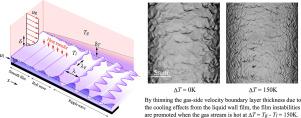Hot shear flows promote instabilities of liquid wall films
IF 5.8
2区 工程技术
Q1 ENGINEERING, MECHANICAL
International Journal of Heat and Mass Transfer
Pub Date : 2025-09-06
DOI:10.1016/j.ijheatmasstransfer.2025.127783
引用次数: 0
Abstract
Liquid films are common in thermal and multiphase flow systems, while the mechanisms of their interfacial instability driven by shear, heat, and evaporation remain elusive. By combining experimental flow visualization with theoretical modeling, this study examines annular gas–liquid two-phase flows under non-isothermal conditions, in which a hot turbulent airflow (, ) heats a room-temperature water film (). Under a fully developed hot airflow and a uniform water film, we observe an enhancement in interfacial instability of three-dimensional ripple wave structures on the wall film: the axial wavelength of ripple waves reduces to approximately half compared to the isothermal case. This remarkable trend is attributed to the cooling effect of the water film on the gas stream, which leads to thinning of the gas-side velocity boundary layer and amplification of shear-induced instabilities visible as the shortened film wavelength. Despite the heating of the liquid film — which decreases surface tension and promotes evaporation — the cooling of the airflow dominates the mechanism for promoted instability. Incorporating the thinning gas-side boundary layer thickness, we formulate the ripple wavelengths under non-isothermal conditions through Kelvin–Helmholtz and Rayleigh–Taylor instability frameworks, well validated by experimental results. Moreover, large-scale disturbance waves are likely to emerge due to increased shear stress at elevated airflow temperatures, with their onset corresponding to a film Weber number of unity. The elucidated mechanism and derived formulation advance the understanding of gas–liquid dynamics with interfacial heat transfer.

热剪切流促进了液壁膜的不稳定性
液体膜在热流和多相流系统中很常见,但其界面不稳定性的机制由剪切、热和蒸发驱动仍然难以捉摸。通过将实验流动可视化与理论建模相结合,本研究研究了非等温条件下的环空气液两相流动,其中热湍流气流(Tg=290 ~ 440K, Nu ~ O(102))加热室温水膜(Tl=290K)。在充分发展的热气流和均匀的水膜条件下,我们观察到壁面膜上三维纹波结构的界面不稳定性增强:纹波的轴向波长比等温条件下减少了大约一半。这种显著的趋势归因于水膜对气流的冷却作用,这导致气侧速度边界层变薄,并且随着水膜波长的缩短,可见剪切引起的不稳定性增强。尽管液体膜的加热降低了表面张力并促进了蒸发,但气流的冷却主导了促进不稳定性的机制。结合气侧边界层厚度变薄的情况,通过Kelvin-Helmholtz和Rayleigh-Taylor不稳定框架推导了非等温条件下的波纹波长,并通过实验结果进行了验证。此外,在较高的气流温度下,由于剪切应力的增加,可能会出现大规模的扰动波,它们的开始与膜韦伯数的单位相对应。所阐明的机理和推导公式促进了对具有界面传热的气液动力学的认识。
本文章由计算机程序翻译,如有差异,请以英文原文为准。
求助全文
约1分钟内获得全文
求助全文
来源期刊
CiteScore
10.30
自引率
13.50%
发文量
1319
审稿时长
41 days
期刊介绍:
International Journal of Heat and Mass Transfer is the vehicle for the exchange of basic ideas in heat and mass transfer between research workers and engineers throughout the world. It focuses on both analytical and experimental research, with an emphasis on contributions which increase the basic understanding of transfer processes and their application to engineering problems.
Topics include:
-New methods of measuring and/or correlating transport-property data
-Energy engineering
-Environmental applications of heat and/or mass transfer

 求助内容:
求助内容: 应助结果提醒方式:
应助结果提醒方式:


